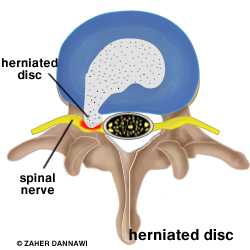What is a Lumbar Disc Prolapse
This is an extremely common condition, frequently referred to as a ‘slipped disc’. The central portion of the lumbar disc (nucleus pulposus) bulges through the surrounding fibrous tissue (annulus fibrosis) and may cause irritation or compression of an adjacent nerve. This often occurs in the presence of an abnormal or degenerate disc, which has a small tear in the annulus fibrosis.

What are the symptoms?
Often the onset of symptoms occurs in the absence of trauma, patients finding it difficult to relate this to any particular event. The pain often starts within the lower back radiating into the buttock and then into the area supplied by the nerve, which is being compressed. This usually affects the back or outer aspect of the leg and can spread down the leg as far as the foot. The pain may be exacerbated by sitting, coughing or sneezing. It may be relieved by standing or lying flat. Patients may experience pins and needles, numbness and occasionally weakness in the leg.
Will you get better?
In most patients the symptoms improve within six weeks with physiotherapy treatment and analgesics. Occasionally, the pain does not improve or there is weakness in the legs. Further investigation may then be required to confirm the diagnosis of a disc prolapse and plan further treatment.
Are there any worrying symptoms?
Very rarely the prolapse disc may press on the central area of nerves known as the cauda equina. The patient may experience sciatica down both legs, which may be associated with numbness of both legs. The condition is particularly urgent if there is numbness around the anus and/or genital area, indicating potential or actual damage to control of the bladder and/or bowel. Cauda equina syndrome is a surgical emergency and if patients have any concerns about this they should consult their doctor without delay, as emergency surgery may be required.
How is a lumbar disc prolapse diagnosed?
The best way to confirm the diagnosis is with an MRI scan of the lumbar spine. The vast majority of patients with an acute disc prolapse will not require a scan as their symptoms will get better with analgesics and physiotherapy. An MRI is indicated when there are persisting or progressive symptoms, or if there are any symptoms to suggest cauda equina syndrome.
What treatment is available?
Conservative Treatment
Improving spinal mobility, strength and overall fitness may improve symptoms to a satisfactory level.
The natural history of the condition is that over 90% of patients will improve without interventional treatment. Simple pain control, using over the counter medication such as Paracetamol or anti inflammmatories, such as Ibuprofen, are helpful. In the early stages diazepam can be used to relieve back spasm and assist mobility.
Spinal Injections
Spinal injections are extremely useful in some patients to help relieve the leg or back pain associated with a disc prolapse, while the natural healing occurs. They have the advantage of being performed under sedation or local anaesthetic and although there are potential risks and side effects, these are extremely rare.
Nerve root blocks, periradicular injections, root canal injections, or transforaminal epidurals are some of the names given to injections around an individual nerve. They can be very helpful for the leg pain caused by lumbar disc prolapses. They may also be used to determine if a particular disc prolapse is causing the pain, this may be very useful when planning surgery.
Epidurals are an injection into the spinal canal that will treat the whole area of the lumbar spine. In both types of injection local anaesthetic and steroid are used. It is estimated that 60% of patients will have significant relief of symptoms, which may be permanent.
Surgery
Surgery, in the form of a lumbar discectomy, (See lumbar discectomy) may be indicated under the following circumstances:
- Central disc prolapse pressing on the nerves to the bladder or bowel (cauda equina syndrome)
- Progressive weakness within the leg
- Severe pain not responding to conservative measures within the first 6 weeks of onset
- Persistent pain affecting activities at 6 weeks or more following conservative measures
What will the long-term effects of a disc prolapse be?
Unfortunately following the disc prolaspe, the disc will always be abnormal. A percentage of patients will experience back pain as a result of the disc prolapse, irrespective of whether surgery is performed or not.
Will the disc prolapse come back?
Approximately 10 percent of patients will experience a recurrent disc prolapse where a further piece of nucleus herniates through the annulus fibrosis and irritates a nerve to cause leg pain. The risk of this is greatest immediately following the operation and decreases with time.
